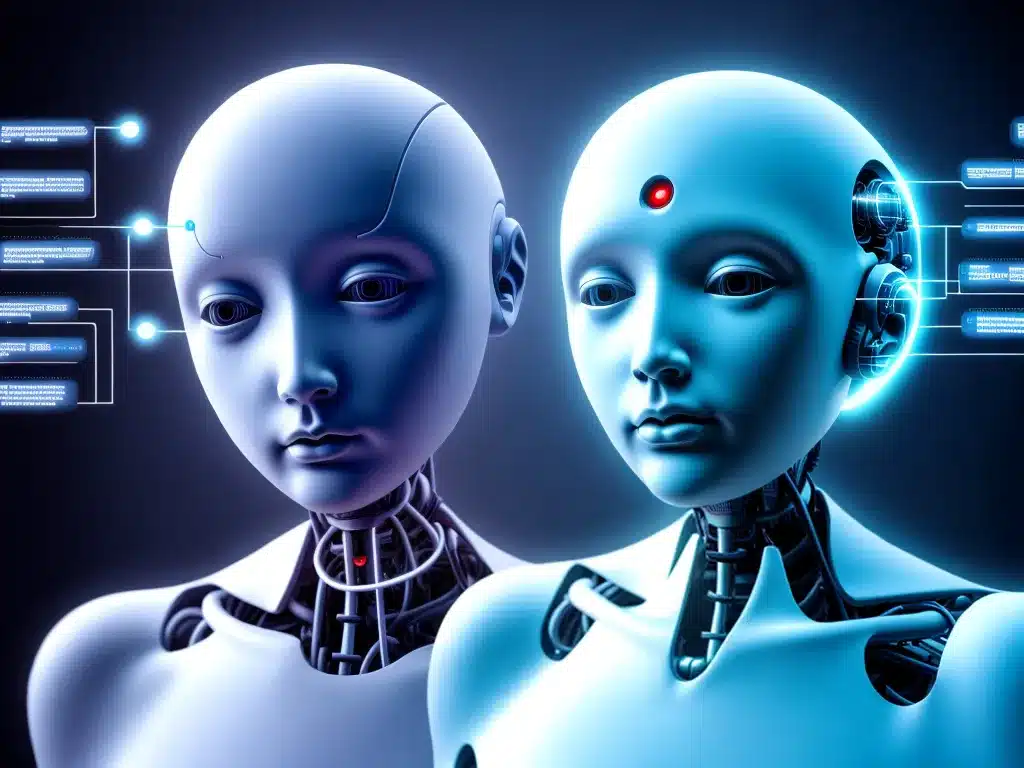Artificial intelligence (AI) has advanced rapidly in recent years. Systems powered by AI are becoming increasingly sophisticated at performing tasks and exhibiting behaviors previously thought to be solely in the domain of humans. There are several key ways modern AI is demonstrating more human-like capabilities:
Natural Language Processing
One area where AI is becoming more human-like is in natural language processing (NLP). NLP refers to an AI system’s ability to understand, interpret, and generate human language. Modern NLP models like BERT, GPT-3, and DALL-E are able to:
-
Understand the nuances of human language and speech – They can comprehend not just the literal meanings of words but also contextual meanings, sarcasm, humor and more.
-
Engage in intelligent dialogue – They can participate in back-and-forth conversations, asking clarifying questions if confused and exhibiting knowledge about the topic being discussed.
-
Generate linguistically coherent text – They can create original stories, articles, poetry, code and more with proper grammar, structure and creativity.
This represents a major leap forward from simple pattern matching towards true language understanding. While still not fully human-level, advanced NLP exhibits far more human qualities in working with language.
Multimodal Understanding
Another aspect of intelligence that AI systems are gaining is multimodal understanding – the ability to comprehend and connect information coming from different senses. Humans integrate sight, sound, touch and more to inform our understanding of the world. Now, AI systems are gaining this capacity.
For example, AI assistants like Siri, Alexa and Google Assistant can now:
-
Interpret visual information – They can identify objects in images and video and understand the relationships between them.
-
Connect speech and images – They can take verbal commands referencing visual inputs, like “What breed of dog is that?”
-
Understand gestures and facial expressions – They recognize hand signals, smiles, frowns and more to better comprehend human behaviors and emotions.
This multisensory comprehension, connecting sight, sound and more, represents an important step towards human-like intelligence.
Emotional Intelligence
Human intelligence is more than just cognitive abilities – it includes emotional intelligence, allowing us to perceive, understand and respond to emotional information. Developing emotional intelligence has long been a challenging area for AI. However, the field of affective computing is enabling more emotionally intelligent machines using:
-
Emotion recognition – Systems can now identify basic emotional states like happiness, sadness, anger, etc. from facial expressions, speech patterns and other inputs.
-
Empathetic dialogue – AI assistants are becoming better at responding supportively, expressing understanding of human emotional needs.
-
Socially aware decision making – AI can factor emotional context into choices, like modulating tone of voice or wording when delivering sensitive news.
While still narrow compared to human emotional depth, progress towards emotionally intelligent AI represents a shift away from cold calculation towards more relatable, humanized interactions.
Common Sense Reasoning
Unlike narrow AI trained for specific tasks, humans possess extensive common sense knowledge accumulated through lifetime experience. We apply this common sense constantly when perceiving, reasoning and making decisions. AI historically lacked this broad base of human common sense, but new approaches are attempting to close this gap:
-
Large common sense databases – Projects like ConceptNet and ATOM compile huge volumes of basic facts and concepts that humans take for granted but must be explicitly provided to AI.
-
Causal reasoning – Systems are getting better at inferring logical causal relationships between events, allowing more common sense predictions.
-
Physical reasoning – AI can now apply basic notions of naïve physics to better understand objects, forces and events in the physical world.
While still far from human common sense reasoning, equipping AI with broader general world knowledge helps make its thinking more grounded and human-like.
Personalized Learning
Humans have an incredible capacity to learn directly from personal experience. We apply knowledge gained from our own unique life events and discoveries. AI systems are increasingly able to learn in similar personalized ways:
-
Reinforcement learning – Algorithms are developed through trial and error, optimizing behaviors based on feedback on what works in practice vs. theory.
-
Meta-learning – Systems can acquire learning techniques themselves, self-reflecting to improve their own learning strategies over time like humans.
-
Lifelong learning – Beyond mastering isolated tasks, AI models are beginning to retain knowledge throughout their lifetimes of experiences.
This ability to learn dynamically from experience rather than solely pre-programmed rules allows AI understanding to become more contextual and personalized like a human’s.
While AI still has a long way to go before matching general human intelligence, remarkable progress has been made towards more human-like capabilities. With continued advances in natural language, multimodal understanding, emotional intelligence, common sense reasoning and personalized learning, the line between artificial and natural intelligence will only grow more blurred. We are steadily marching towards an intelligent technology future that promises to be more collaborative and relatable than ever.













